Hand Cleaning Project: An Analysis of Hand Hygiene in Healthcare
VerifiedAdded on 2023/06/10
|23
|5917
|219
Report
AI Summary
This report, titled "Hand Cleaning Project," delves into the critical importance of hand hygiene within healthcare settings. It begins by defining hand cleaning and its role in removing dirt, soil, and microorganisms, emphasizing the superiority of soap and water over plain water, and discussing the use of alternatives like ash when soap is unavailable. The report then provides a comprehensive literature review, tracing the historical significance of hand hygiene and detailing various methods, including medical hand hygiene. It highlights the benefits of handwashing, such as minimizing disease spread and preventing waterborne and respiratory infections, and examines the impact of handwashing on mortality rates in developing countries. The report also explores the substances used in hand cleaning, including soap, detergents, water, hand antiseptics, and alternatives like ash, while also detailing proper handwashing techniques and the importance of drying hands effectively. Furthermore, the report aims to analyze handwashing techniques, risks, bacterial flora, nosocomial infections, and the use of sanitizers to improve healthcare practices.
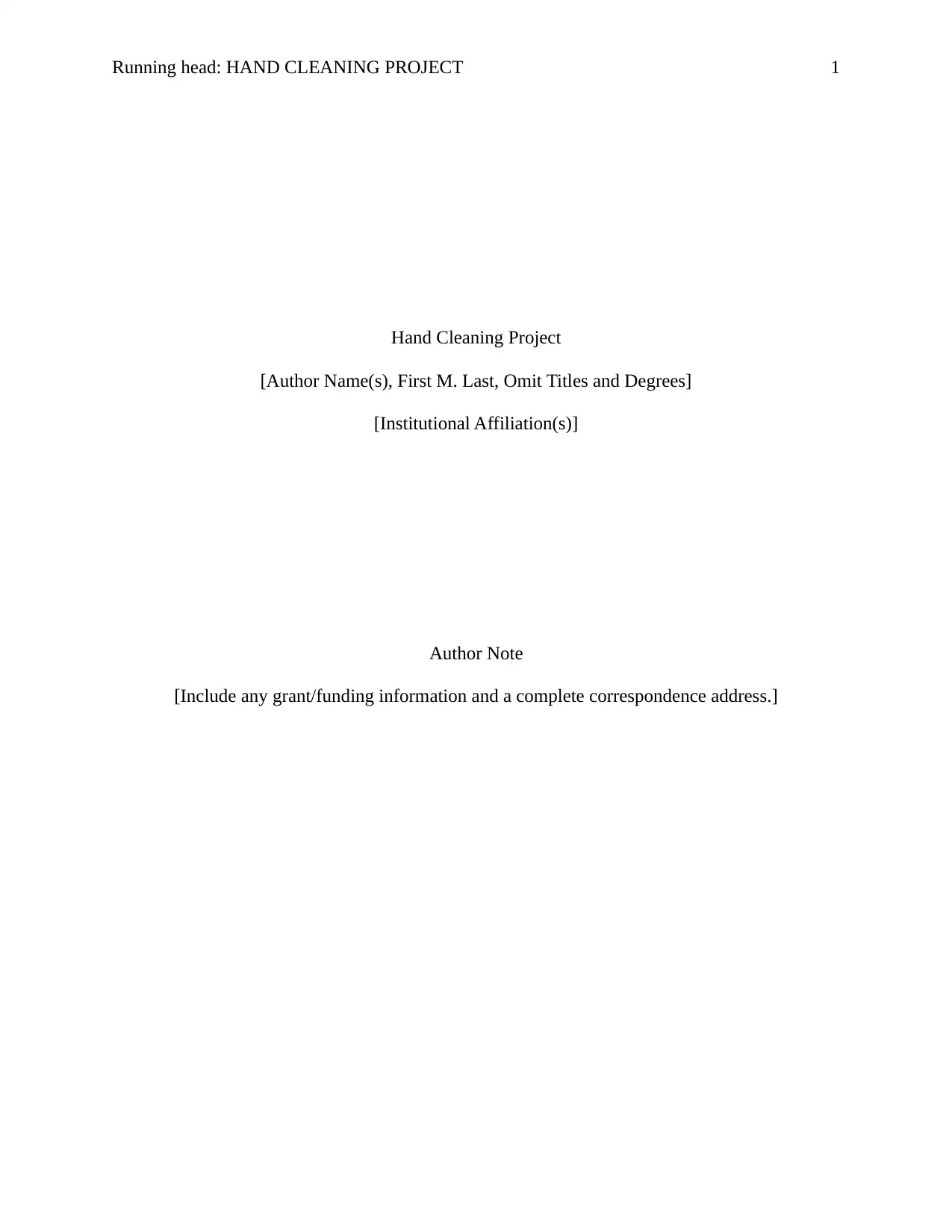
Running head: HAND CLEANING PROJECT 1
Hand Cleaning Project
[Author Name(s), First M. Last, Omit Titles and Degrees]
[Institutional Affiliation(s)]
Author Note
[Include any grant/funding information and a complete correspondence address.]
Hand Cleaning Project
[Author Name(s), First M. Last, Omit Titles and Degrees]
[Institutional Affiliation(s)]
Author Note
[Include any grant/funding information and a complete correspondence address.]
Paraphrase This Document
Need a fresh take? Get an instant paraphrase of this document with our AI Paraphraser
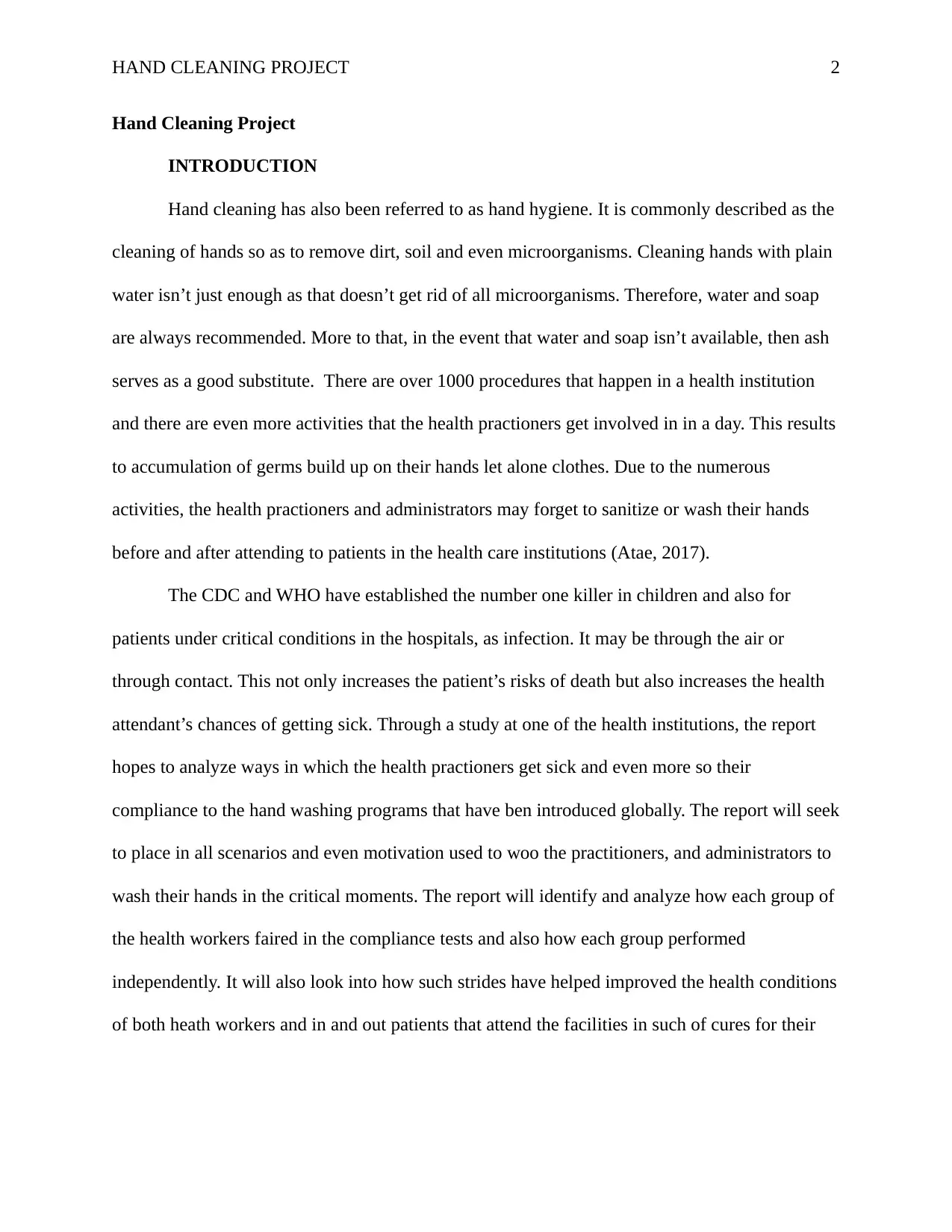
HAND CLEANING PROJECT 2
Hand Cleaning Project
INTRODUCTION
Hand cleaning has also been referred to as hand hygiene. It is commonly described as the
cleaning of hands so as to remove dirt, soil and even microorganisms. Cleaning hands with plain
water isn’t just enough as that doesn’t get rid of all microorganisms. Therefore, water and soap
are always recommended. More to that, in the event that water and soap isn’t available, then ash
serves as a good substitute. There are over 1000 procedures that happen in a health institution
and there are even more activities that the health practioners get involved in in a day. This results
to accumulation of germs build up on their hands let alone clothes. Due to the numerous
activities, the health practioners and administrators may forget to sanitize or wash their hands
before and after attending to patients in the health care institutions (Atae, 2017).
The CDC and WHO have established the number one killer in children and also for
patients under critical conditions in the hospitals, as infection. It may be through the air or
through contact. This not only increases the patient’s risks of death but also increases the health
attendant’s chances of getting sick. Through a study at one of the health institutions, the report
hopes to analyze ways in which the health practioners get sick and even more so their
compliance to the hand washing programs that have ben introduced globally. The report will seek
to place in all scenarios and even motivation used to woo the practitioners, and administrators to
wash their hands in the critical moments. The report will identify and analyze how each group of
the health workers faired in the compliance tests and also how each group performed
independently. It will also look into how such strides have helped improved the health conditions
of both heath workers and in and out patients that attend the facilities in such of cures for their
Hand Cleaning Project
INTRODUCTION
Hand cleaning has also been referred to as hand hygiene. It is commonly described as the
cleaning of hands so as to remove dirt, soil and even microorganisms. Cleaning hands with plain
water isn’t just enough as that doesn’t get rid of all microorganisms. Therefore, water and soap
are always recommended. More to that, in the event that water and soap isn’t available, then ash
serves as a good substitute. There are over 1000 procedures that happen in a health institution
and there are even more activities that the health practioners get involved in in a day. This results
to accumulation of germs build up on their hands let alone clothes. Due to the numerous
activities, the health practioners and administrators may forget to sanitize or wash their hands
before and after attending to patients in the health care institutions (Atae, 2017).
The CDC and WHO have established the number one killer in children and also for
patients under critical conditions in the hospitals, as infection. It may be through the air or
through contact. This not only increases the patient’s risks of death but also increases the health
attendant’s chances of getting sick. Through a study at one of the health institutions, the report
hopes to analyze ways in which the health practioners get sick and even more so their
compliance to the hand washing programs that have ben introduced globally. The report will seek
to place in all scenarios and even motivation used to woo the practitioners, and administrators to
wash their hands in the critical moments. The report will identify and analyze how each group of
the health workers faired in the compliance tests and also how each group performed
independently. It will also look into how such strides have helped improved the health conditions
of both heath workers and in and out patients that attend the facilities in such of cures for their
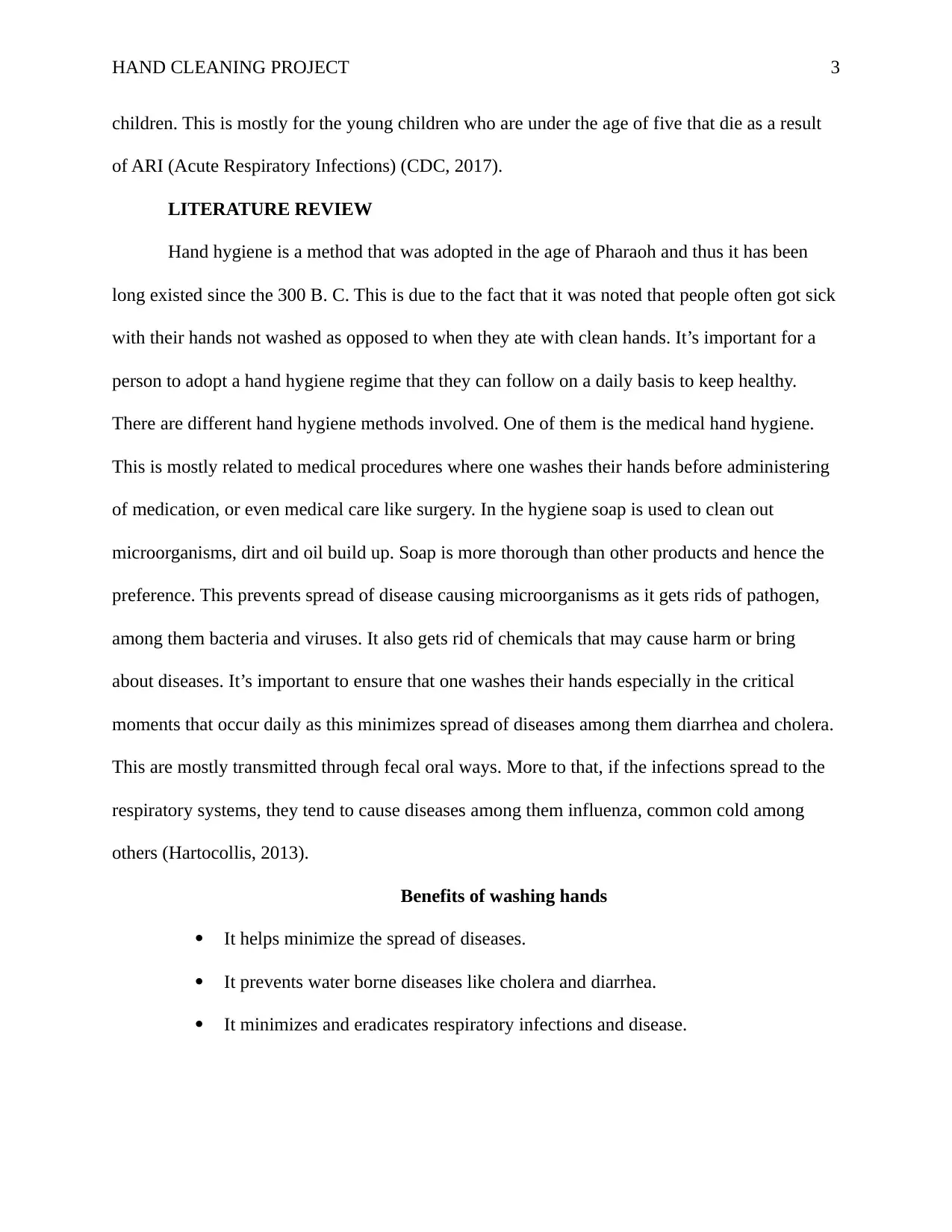
HAND CLEANING PROJECT 3
children. This is mostly for the young children who are under the age of five that die as a result
of ARI (Acute Respiratory Infections) (CDC, 2017).
LITERATURE REVIEW
Hand hygiene is a method that was adopted in the age of Pharaoh and thus it has been
long existed since the 300 B. C. This is due to the fact that it was noted that people often got sick
with their hands not washed as opposed to when they ate with clean hands. It’s important for a
person to adopt a hand hygiene regime that they can follow on a daily basis to keep healthy.
There are different hand hygiene methods involved. One of them is the medical hand hygiene.
This is mostly related to medical procedures where one washes their hands before administering
of medication, or even medical care like surgery. In the hygiene soap is used to clean out
microorganisms, dirt and oil build up. Soap is more thorough than other products and hence the
preference. This prevents spread of disease causing microorganisms as it gets rids of pathogen,
among them bacteria and viruses. It also gets rid of chemicals that may cause harm or bring
about diseases. It’s important to ensure that one washes their hands especially in the critical
moments that occur daily as this minimizes spread of diseases among them diarrhea and cholera.
This are mostly transmitted through fecal oral ways. More to that, if the infections spread to the
respiratory systems, they tend to cause diseases among them influenza, common cold among
others (Hartocollis, 2013).
Benefits of washing hands
It helps minimize the spread of diseases.
It prevents water borne diseases like cholera and diarrhea.
It minimizes and eradicates respiratory infections and disease.
children. This is mostly for the young children who are under the age of five that die as a result
of ARI (Acute Respiratory Infections) (CDC, 2017).
LITERATURE REVIEW
Hand hygiene is a method that was adopted in the age of Pharaoh and thus it has been
long existed since the 300 B. C. This is due to the fact that it was noted that people often got sick
with their hands not washed as opposed to when they ate with clean hands. It’s important for a
person to adopt a hand hygiene regime that they can follow on a daily basis to keep healthy.
There are different hand hygiene methods involved. One of them is the medical hand hygiene.
This is mostly related to medical procedures where one washes their hands before administering
of medication, or even medical care like surgery. In the hygiene soap is used to clean out
microorganisms, dirt and oil build up. Soap is more thorough than other products and hence the
preference. This prevents spread of disease causing microorganisms as it gets rids of pathogen,
among them bacteria and viruses. It also gets rid of chemicals that may cause harm or bring
about diseases. It’s important to ensure that one washes their hands especially in the critical
moments that occur daily as this minimizes spread of diseases among them diarrhea and cholera.
This are mostly transmitted through fecal oral ways. More to that, if the infections spread to the
respiratory systems, they tend to cause diseases among them influenza, common cold among
others (Hartocollis, 2013).
Benefits of washing hands
It helps minimize the spread of diseases.
It prevents water borne diseases like cholera and diarrhea.
It minimizes and eradicates respiratory infections and disease.
⊘ This is a preview!⊘
Do you want full access?
Subscribe today to unlock all pages.

Trusted by 1+ million students worldwide
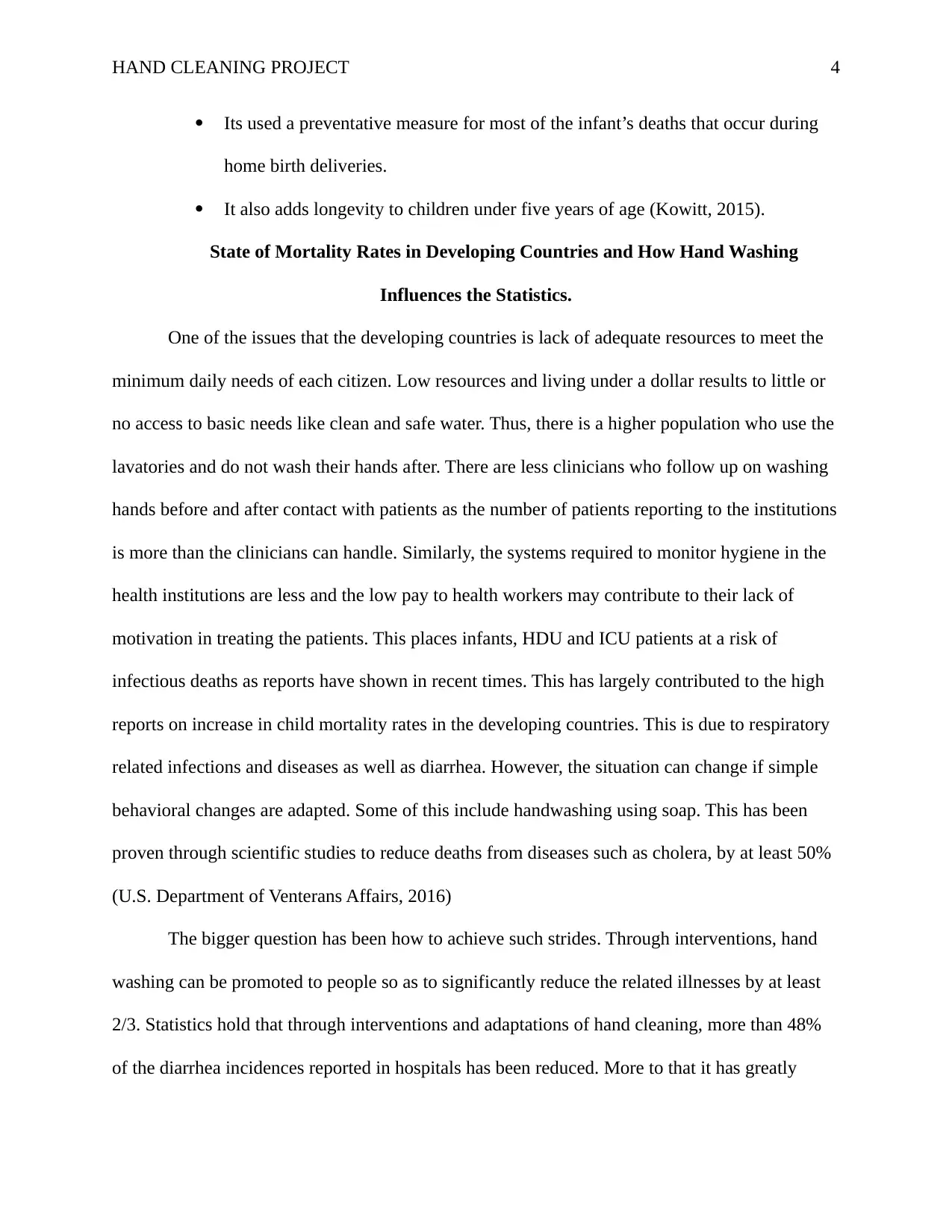
HAND CLEANING PROJECT 4
Its used a preventative measure for most of the infant’s deaths that occur during
home birth deliveries.
It also adds longevity to children under five years of age (Kowitt, 2015).
State of Mortality Rates in Developing Countries and How Hand Washing
Influences the Statistics.
One of the issues that the developing countries is lack of adequate resources to meet the
minimum daily needs of each citizen. Low resources and living under a dollar results to little or
no access to basic needs like clean and safe water. Thus, there is a higher population who use the
lavatories and do not wash their hands after. There are less clinicians who follow up on washing
hands before and after contact with patients as the number of patients reporting to the institutions
is more than the clinicians can handle. Similarly, the systems required to monitor hygiene in the
health institutions are less and the low pay to health workers may contribute to their lack of
motivation in treating the patients. This places infants, HDU and ICU patients at a risk of
infectious deaths as reports have shown in recent times. This has largely contributed to the high
reports on increase in child mortality rates in the developing countries. This is due to respiratory
related infections and diseases as well as diarrhea. However, the situation can change if simple
behavioral changes are adapted. Some of this include handwashing using soap. This has been
proven through scientific studies to reduce deaths from diseases such as cholera, by at least 50%
(U.S. Department of Venterans Affairs, 2016)
The bigger question has been how to achieve such strides. Through interventions, hand
washing can be promoted to people so as to significantly reduce the related illnesses by at least
2/3. Statistics hold that through interventions and adaptations of hand cleaning, more than 48%
of the diarrhea incidences reported in hospitals has been reduced. More to that it has greatly
Its used a preventative measure for most of the infant’s deaths that occur during
home birth deliveries.
It also adds longevity to children under five years of age (Kowitt, 2015).
State of Mortality Rates in Developing Countries and How Hand Washing
Influences the Statistics.
One of the issues that the developing countries is lack of adequate resources to meet the
minimum daily needs of each citizen. Low resources and living under a dollar results to little or
no access to basic needs like clean and safe water. Thus, there is a higher population who use the
lavatories and do not wash their hands after. There are less clinicians who follow up on washing
hands before and after contact with patients as the number of patients reporting to the institutions
is more than the clinicians can handle. Similarly, the systems required to monitor hygiene in the
health institutions are less and the low pay to health workers may contribute to their lack of
motivation in treating the patients. This places infants, HDU and ICU patients at a risk of
infectious deaths as reports have shown in recent times. This has largely contributed to the high
reports on increase in child mortality rates in the developing countries. This is due to respiratory
related infections and diseases as well as diarrhea. However, the situation can change if simple
behavioral changes are adapted. Some of this include handwashing using soap. This has been
proven through scientific studies to reduce deaths from diseases such as cholera, by at least 50%
(U.S. Department of Venterans Affairs, 2016)
The bigger question has been how to achieve such strides. Through interventions, hand
washing can be promoted to people so as to significantly reduce the related illnesses by at least
2/3. Statistics hold that through interventions and adaptations of hand cleaning, more than 48%
of the diarrhea incidences reported in hospitals has been reduced. More to that it has greatly
Paraphrase This Document
Need a fresh take? Get an instant paraphrase of this document with our AI Paraphraser
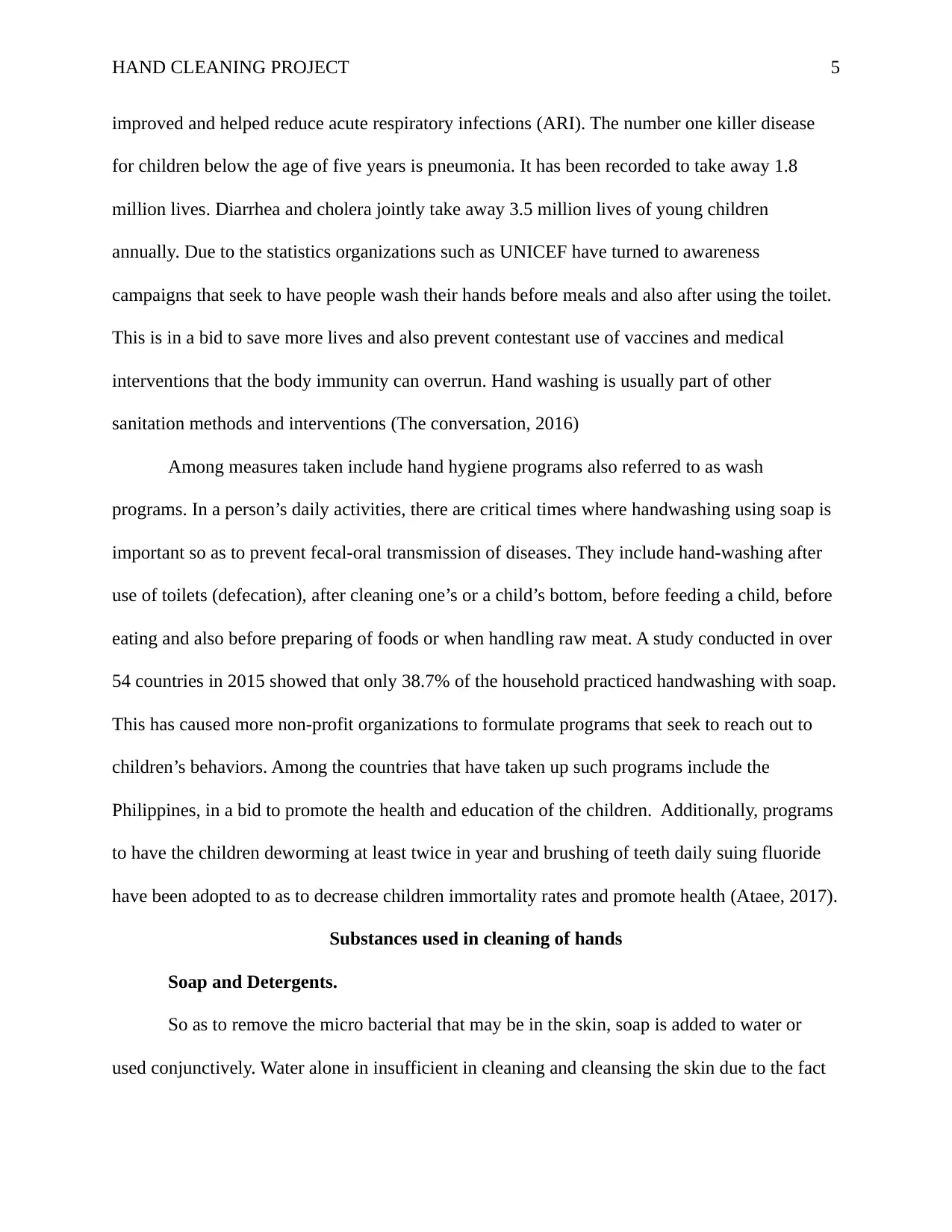
HAND CLEANING PROJECT 5
improved and helped reduce acute respiratory infections (ARI). The number one killer disease
for children below the age of five years is pneumonia. It has been recorded to take away 1.8
million lives. Diarrhea and cholera jointly take away 3.5 million lives of young children
annually. Due to the statistics organizations such as UNICEF have turned to awareness
campaigns that seek to have people wash their hands before meals and also after using the toilet.
This is in a bid to save more lives and also prevent contestant use of vaccines and medical
interventions that the body immunity can overrun. Hand washing is usually part of other
sanitation methods and interventions (The conversation, 2016)
Among measures taken include hand hygiene programs also referred to as wash
programs. In a person’s daily activities, there are critical times where handwashing using soap is
important so as to prevent fecal-oral transmission of diseases. They include hand-washing after
use of toilets (defecation), after cleaning one’s or a child’s bottom, before feeding a child, before
eating and also before preparing of foods or when handling raw meat. A study conducted in over
54 countries in 2015 showed that only 38.7% of the household practiced handwashing with soap.
This has caused more non-profit organizations to formulate programs that seek to reach out to
children’s behaviors. Among the countries that have taken up such programs include the
Philippines, in a bid to promote the health and education of the children. Additionally, programs
to have the children deworming at least twice in year and brushing of teeth daily suing fluoride
have been adopted to as to decrease children immortality rates and promote health (Ataee, 2017).
Substances used in cleaning of hands
Soap and Detergents.
So as to remove the micro bacterial that may be in the skin, soap is added to water or
used conjunctively. Water alone in insufficient in cleaning and cleansing the skin due to the fact
improved and helped reduce acute respiratory infections (ARI). The number one killer disease
for children below the age of five years is pneumonia. It has been recorded to take away 1.8
million lives. Diarrhea and cholera jointly take away 3.5 million lives of young children
annually. Due to the statistics organizations such as UNICEF have turned to awareness
campaigns that seek to have people wash their hands before meals and also after using the toilet.
This is in a bid to save more lives and also prevent contestant use of vaccines and medical
interventions that the body immunity can overrun. Hand washing is usually part of other
sanitation methods and interventions (The conversation, 2016)
Among measures taken include hand hygiene programs also referred to as wash
programs. In a person’s daily activities, there are critical times where handwashing using soap is
important so as to prevent fecal-oral transmission of diseases. They include hand-washing after
use of toilets (defecation), after cleaning one’s or a child’s bottom, before feeding a child, before
eating and also before preparing of foods or when handling raw meat. A study conducted in over
54 countries in 2015 showed that only 38.7% of the household practiced handwashing with soap.
This has caused more non-profit organizations to formulate programs that seek to reach out to
children’s behaviors. Among the countries that have taken up such programs include the
Philippines, in a bid to promote the health and education of the children. Additionally, programs
to have the children deworming at least twice in year and brushing of teeth daily suing fluoride
have been adopted to as to decrease children immortality rates and promote health (Ataee, 2017).
Substances used in cleaning of hands
Soap and Detergents.
So as to remove the micro bacterial that may be in the skin, soap is added to water or
used conjunctively. Water alone in insufficient in cleaning and cleansing the skin due to the fact
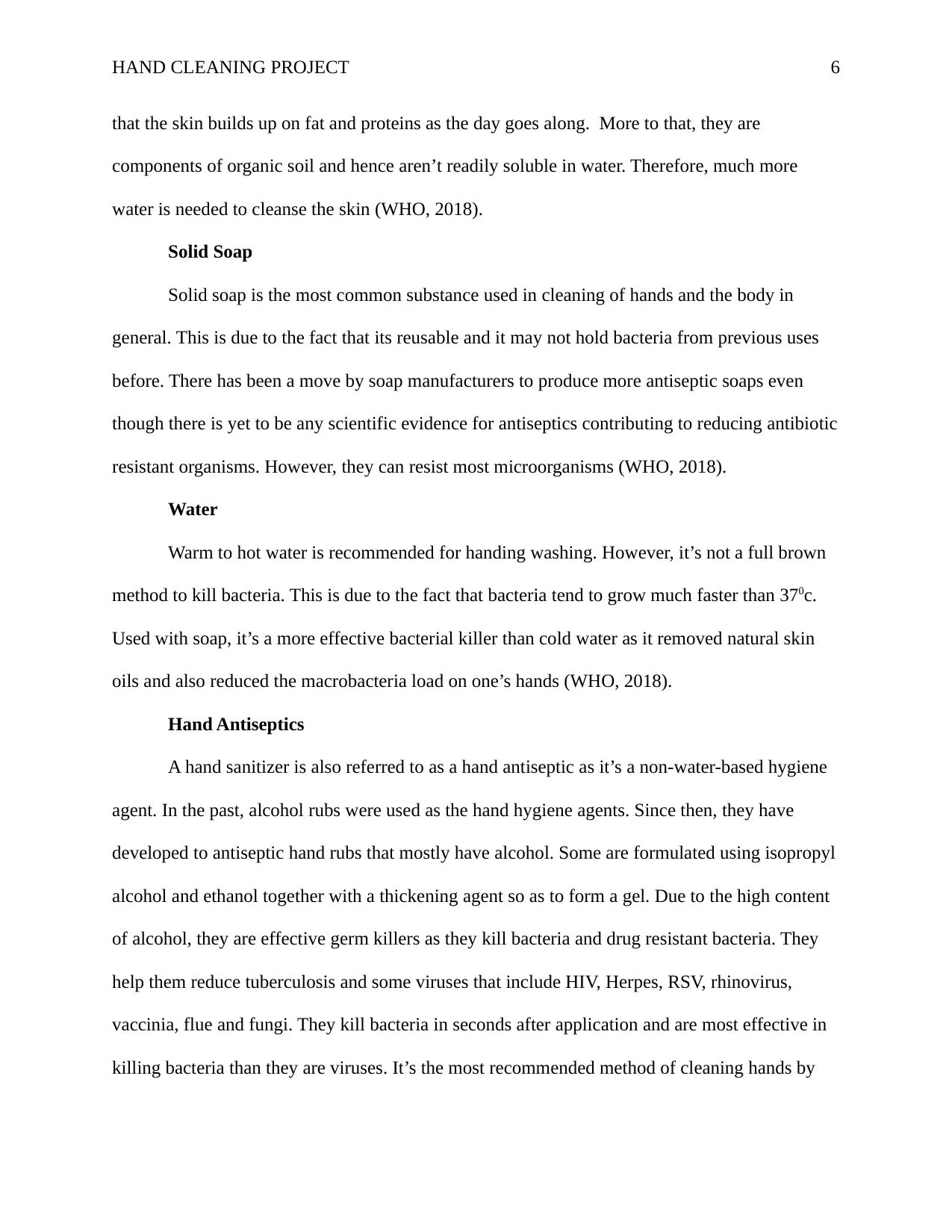
HAND CLEANING PROJECT 6
that the skin builds up on fat and proteins as the day goes along. More to that, they are
components of organic soil and hence aren’t readily soluble in water. Therefore, much more
water is needed to cleanse the skin (WHO, 2018).
Solid Soap
Solid soap is the most common substance used in cleaning of hands and the body in
general. This is due to the fact that its reusable and it may not hold bacteria from previous uses
before. There has been a move by soap manufacturers to produce more antiseptic soaps even
though there is yet to be any scientific evidence for antiseptics contributing to reducing antibiotic
resistant organisms. However, they can resist most microorganisms (WHO, 2018).
Water
Warm to hot water is recommended for handing washing. However, it’s not a full brown
method to kill bacteria. This is due to the fact that bacteria tend to grow much faster than 370c.
Used with soap, it’s a more effective bacterial killer than cold water as it removed natural skin
oils and also reduced the macrobacteria load on one’s hands (WHO, 2018).
Hand Antiseptics
A hand sanitizer is also referred to as a hand antiseptic as it’s a non-water-based hygiene
agent. In the past, alcohol rubs were used as the hand hygiene agents. Since then, they have
developed to antiseptic hand rubs that mostly have alcohol. Some are formulated using isopropyl
alcohol and ethanol together with a thickening agent so as to form a gel. Due to the high content
of alcohol, they are effective germ killers as they kill bacteria and drug resistant bacteria. They
help them reduce tuberculosis and some viruses that include HIV, Herpes, RSV, rhinovirus,
vaccinia, flue and fungi. They kill bacteria in seconds after application and are most effective in
killing bacteria than they are viruses. It’s the most recommended method of cleaning hands by
that the skin builds up on fat and proteins as the day goes along. More to that, they are
components of organic soil and hence aren’t readily soluble in water. Therefore, much more
water is needed to cleanse the skin (WHO, 2018).
Solid Soap
Solid soap is the most common substance used in cleaning of hands and the body in
general. This is due to the fact that its reusable and it may not hold bacteria from previous uses
before. There has been a move by soap manufacturers to produce more antiseptic soaps even
though there is yet to be any scientific evidence for antiseptics contributing to reducing antibiotic
resistant organisms. However, they can resist most microorganisms (WHO, 2018).
Water
Warm to hot water is recommended for handing washing. However, it’s not a full brown
method to kill bacteria. This is due to the fact that bacteria tend to grow much faster than 370c.
Used with soap, it’s a more effective bacterial killer than cold water as it removed natural skin
oils and also reduced the macrobacteria load on one’s hands (WHO, 2018).
Hand Antiseptics
A hand sanitizer is also referred to as a hand antiseptic as it’s a non-water-based hygiene
agent. In the past, alcohol rubs were used as the hand hygiene agents. Since then, they have
developed to antiseptic hand rubs that mostly have alcohol. Some are formulated using isopropyl
alcohol and ethanol together with a thickening agent so as to form a gel. Due to the high content
of alcohol, they are effective germ killers as they kill bacteria and drug resistant bacteria. They
help them reduce tuberculosis and some viruses that include HIV, Herpes, RSV, rhinovirus,
vaccinia, flue and fungi. They kill bacteria in seconds after application and are most effective in
killing bacteria than they are viruses. It’s the most recommended method of cleaning hands by
⊘ This is a preview!⊘
Do you want full access?
Subscribe today to unlock all pages.

Trusted by 1+ million students worldwide
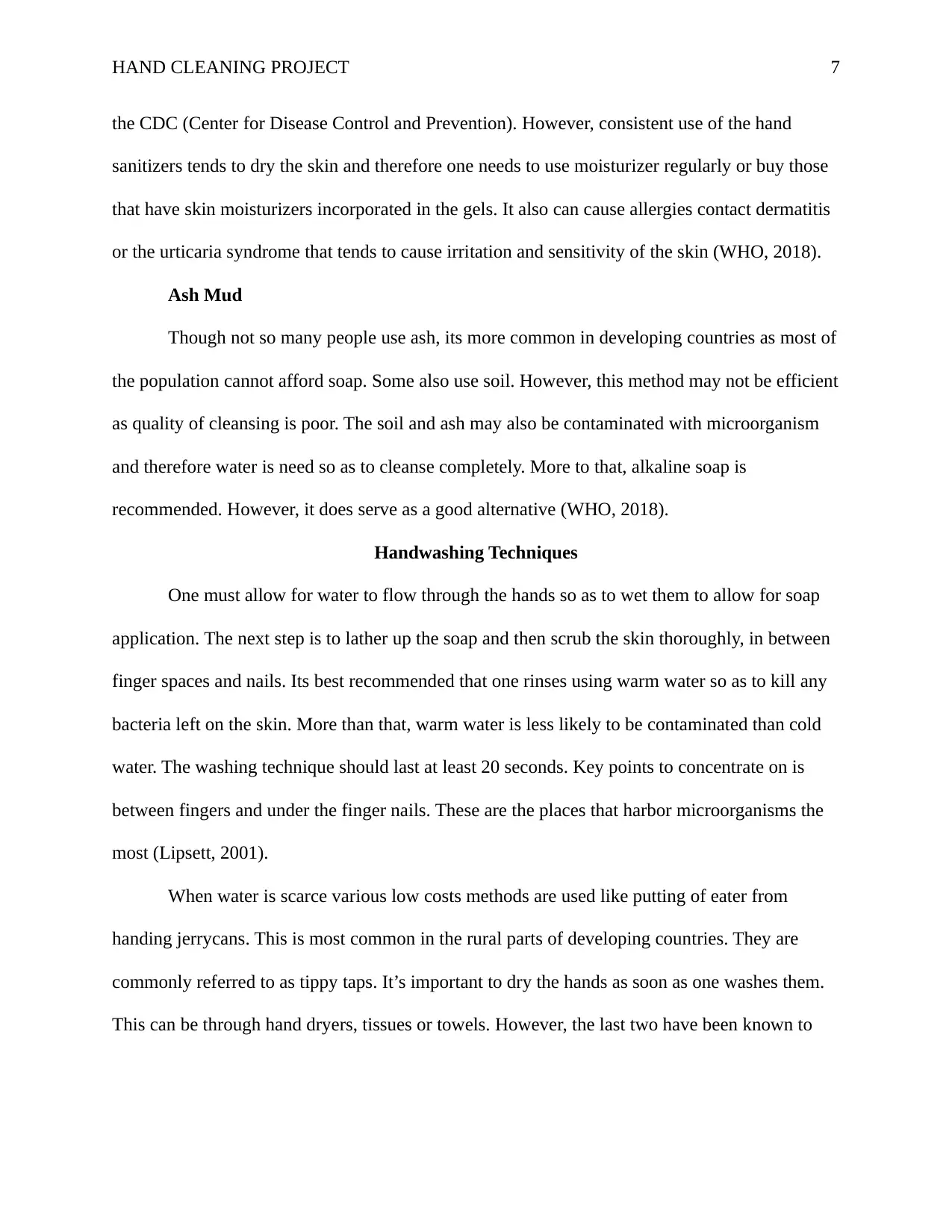
HAND CLEANING PROJECT 7
the CDC (Center for Disease Control and Prevention). However, consistent use of the hand
sanitizers tends to dry the skin and therefore one needs to use moisturizer regularly or buy those
that have skin moisturizers incorporated in the gels. It also can cause allergies contact dermatitis
or the urticaria syndrome that tends to cause irritation and sensitivity of the skin (WHO, 2018).
Ash Mud
Though not so many people use ash, its more common in developing countries as most of
the population cannot afford soap. Some also use soil. However, this method may not be efficient
as quality of cleansing is poor. The soil and ash may also be contaminated with microorganism
and therefore water is need so as to cleanse completely. More to that, alkaline soap is
recommended. However, it does serve as a good alternative (WHO, 2018).
Handwashing Techniques
One must allow for water to flow through the hands so as to wet them to allow for soap
application. The next step is to lather up the soap and then scrub the skin thoroughly, in between
finger spaces and nails. Its best recommended that one rinses using warm water so as to kill any
bacteria left on the skin. More than that, warm water is less likely to be contaminated than cold
water. The washing technique should last at least 20 seconds. Key points to concentrate on is
between fingers and under the finger nails. These are the places that harbor microorganisms the
most (Lipsett, 2001).
When water is scarce various low costs methods are used like putting of eater from
handing jerrycans. This is most common in the rural parts of developing countries. They are
commonly referred to as tippy taps. It’s important to dry the hands as soon as one washes them.
This can be through hand dryers, tissues or towels. However, the last two have been known to
the CDC (Center for Disease Control and Prevention). However, consistent use of the hand
sanitizers tends to dry the skin and therefore one needs to use moisturizer regularly or buy those
that have skin moisturizers incorporated in the gels. It also can cause allergies contact dermatitis
or the urticaria syndrome that tends to cause irritation and sensitivity of the skin (WHO, 2018).
Ash Mud
Though not so many people use ash, its more common in developing countries as most of
the population cannot afford soap. Some also use soil. However, this method may not be efficient
as quality of cleansing is poor. The soil and ash may also be contaminated with microorganism
and therefore water is need so as to cleanse completely. More to that, alkaline soap is
recommended. However, it does serve as a good alternative (WHO, 2018).
Handwashing Techniques
One must allow for water to flow through the hands so as to wet them to allow for soap
application. The next step is to lather up the soap and then scrub the skin thoroughly, in between
finger spaces and nails. Its best recommended that one rinses using warm water so as to kill any
bacteria left on the skin. More than that, warm water is less likely to be contaminated than cold
water. The washing technique should last at least 20 seconds. Key points to concentrate on is
between fingers and under the finger nails. These are the places that harbor microorganisms the
most (Lipsett, 2001).
When water is scarce various low costs methods are used like putting of eater from
handing jerrycans. This is most common in the rural parts of developing countries. They are
commonly referred to as tippy taps. It’s important to dry the hands as soon as one washes them.
This can be through hand dryers, tissues or towels. However, the last two have been known to
Paraphrase This Document
Need a fresh take? Get an instant paraphrase of this document with our AI Paraphraser
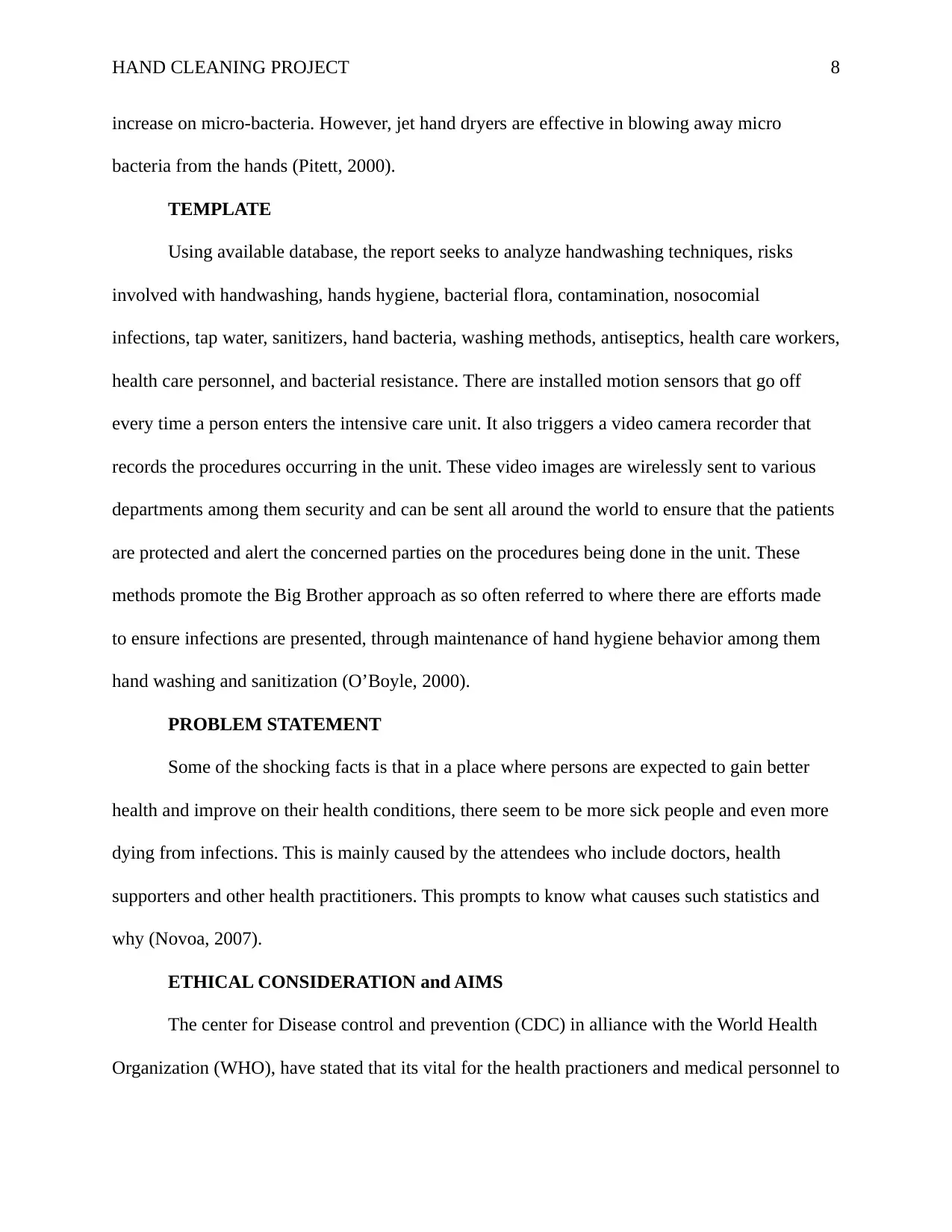
HAND CLEANING PROJECT 8
increase on micro-bacteria. However, jet hand dryers are effective in blowing away micro
bacteria from the hands (Pitett, 2000).
TEMPLATE
Using available database, the report seeks to analyze handwashing techniques, risks
involved with handwashing, hands hygiene, bacterial flora, contamination, nosocomial
infections, tap water, sanitizers, hand bacteria, washing methods, antiseptics, health care workers,
health care personnel, and bacterial resistance. There are installed motion sensors that go off
every time a person enters the intensive care unit. It also triggers a video camera recorder that
records the procedures occurring in the unit. These video images are wirelessly sent to various
departments among them security and can be sent all around the world to ensure that the patients
are protected and alert the concerned parties on the procedures being done in the unit. These
methods promote the Big Brother approach as so often referred to where there are efforts made
to ensure infections are presented, through maintenance of hand hygiene behavior among them
hand washing and sanitization (O’Boyle, 2000).
PROBLEM STATEMENT
Some of the shocking facts is that in a place where persons are expected to gain better
health and improve on their health conditions, there seem to be more sick people and even more
dying from infections. This is mainly caused by the attendees who include doctors, health
supporters and other health practitioners. This prompts to know what causes such statistics and
why (Novoa, 2007).
ETHICAL CONSIDERATION and AIMS
The center for Disease control and prevention (CDC) in alliance with the World Health
Organization (WHO), have stated that its vital for the health practioners and medical personnel to
increase on micro-bacteria. However, jet hand dryers are effective in blowing away micro
bacteria from the hands (Pitett, 2000).
TEMPLATE
Using available database, the report seeks to analyze handwashing techniques, risks
involved with handwashing, hands hygiene, bacterial flora, contamination, nosocomial
infections, tap water, sanitizers, hand bacteria, washing methods, antiseptics, health care workers,
health care personnel, and bacterial resistance. There are installed motion sensors that go off
every time a person enters the intensive care unit. It also triggers a video camera recorder that
records the procedures occurring in the unit. These video images are wirelessly sent to various
departments among them security and can be sent all around the world to ensure that the patients
are protected and alert the concerned parties on the procedures being done in the unit. These
methods promote the Big Brother approach as so often referred to where there are efforts made
to ensure infections are presented, through maintenance of hand hygiene behavior among them
hand washing and sanitization (O’Boyle, 2000).
PROBLEM STATEMENT
Some of the shocking facts is that in a place where persons are expected to gain better
health and improve on their health conditions, there seem to be more sick people and even more
dying from infections. This is mainly caused by the attendees who include doctors, health
supporters and other health practitioners. This prompts to know what causes such statistics and
why (Novoa, 2007).
ETHICAL CONSIDERATION and AIMS
The center for Disease control and prevention (CDC) in alliance with the World Health
Organization (WHO), have stated that its vital for the health practioners and medical personnel to
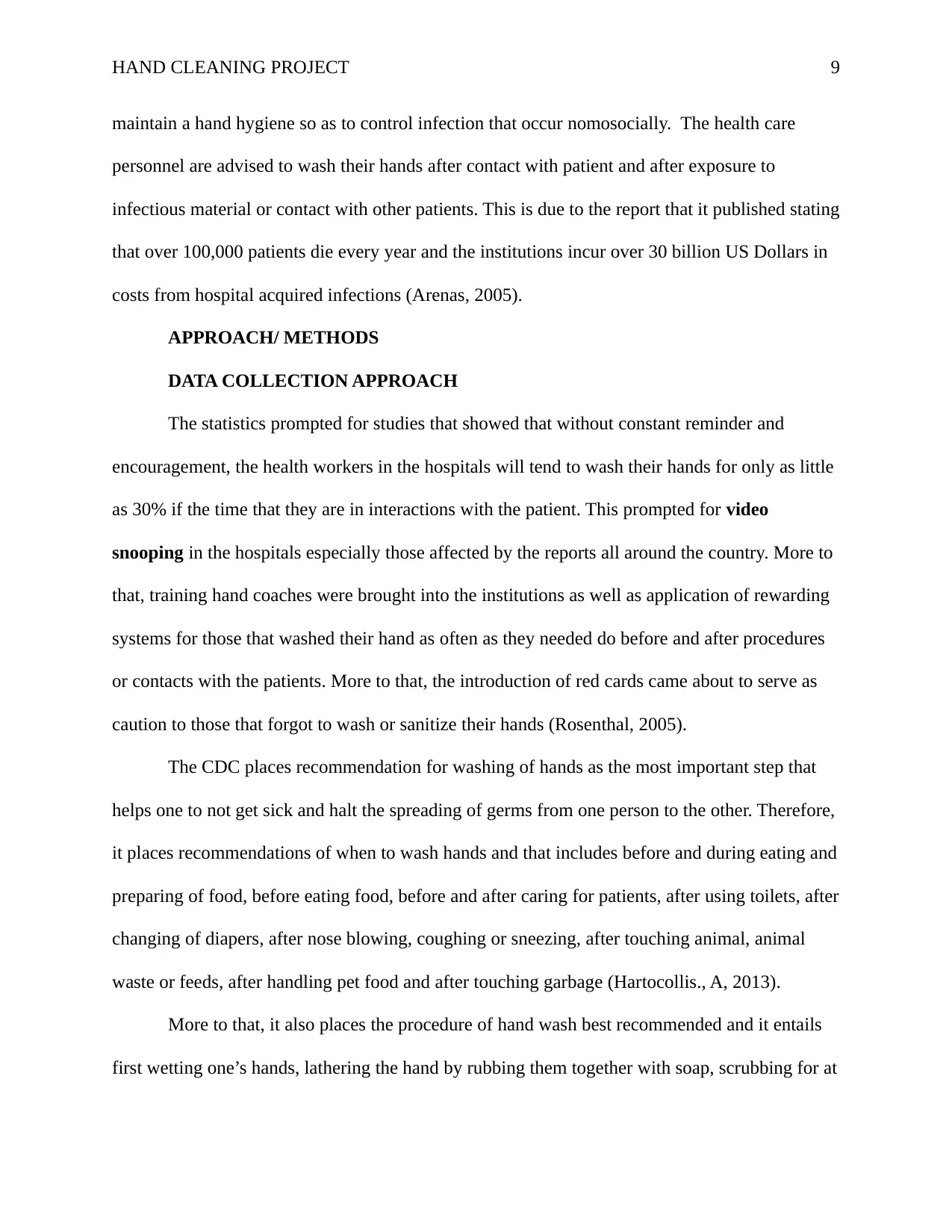
HAND CLEANING PROJECT 9
maintain a hand hygiene so as to control infection that occur nomosocially. The health care
personnel are advised to wash their hands after contact with patient and after exposure to
infectious material or contact with other patients. This is due to the report that it published stating
that over 100,000 patients die every year and the institutions incur over 30 billion US Dollars in
costs from hospital acquired infections (Arenas, 2005).
APPROACH/ METHODS
DATA COLLECTION APPROACH
The statistics prompted for studies that showed that without constant reminder and
encouragement, the health workers in the hospitals will tend to wash their hands for only as little
as 30% if the time that they are in interactions with the patient. This prompted for video
snooping in the hospitals especially those affected by the reports all around the country. More to
that, training hand coaches were brought into the institutions as well as application of rewarding
systems for those that washed their hand as often as they needed do before and after procedures
or contacts with the patients. More to that, the introduction of red cards came about to serve as
caution to those that forgot to wash or sanitize their hands (Rosenthal, 2005).
The CDC places recommendation for washing of hands as the most important step that
helps one to not get sick and halt the spreading of germs from one person to the other. Therefore,
it places recommendations of when to wash hands and that includes before and during eating and
preparing of food, before eating food, before and after caring for patients, after using toilets, after
changing of diapers, after nose blowing, coughing or sneezing, after touching animal, animal
waste or feeds, after handling pet food and after touching garbage (Hartocollis., A, 2013).
More to that, it also places the procedure of hand wash best recommended and it entails
first wetting one’s hands, lathering the hand by rubbing them together with soap, scrubbing for at
maintain a hand hygiene so as to control infection that occur nomosocially. The health care
personnel are advised to wash their hands after contact with patient and after exposure to
infectious material or contact with other patients. This is due to the report that it published stating
that over 100,000 patients die every year and the institutions incur over 30 billion US Dollars in
costs from hospital acquired infections (Arenas, 2005).
APPROACH/ METHODS
DATA COLLECTION APPROACH
The statistics prompted for studies that showed that without constant reminder and
encouragement, the health workers in the hospitals will tend to wash their hands for only as little
as 30% if the time that they are in interactions with the patient. This prompted for video
snooping in the hospitals especially those affected by the reports all around the country. More to
that, training hand coaches were brought into the institutions as well as application of rewarding
systems for those that washed their hand as often as they needed do before and after procedures
or contacts with the patients. More to that, the introduction of red cards came about to serve as
caution to those that forgot to wash or sanitize their hands (Rosenthal, 2005).
The CDC places recommendation for washing of hands as the most important step that
helps one to not get sick and halt the spreading of germs from one person to the other. Therefore,
it places recommendations of when to wash hands and that includes before and during eating and
preparing of food, before eating food, before and after caring for patients, after using toilets, after
changing of diapers, after nose blowing, coughing or sneezing, after touching animal, animal
waste or feeds, after handling pet food and after touching garbage (Hartocollis., A, 2013).
More to that, it also places the procedure of hand wash best recommended and it entails
first wetting one’s hands, lathering the hand by rubbing them together with soap, scrubbing for at
⊘ This is a preview!⊘
Do you want full access?
Subscribe today to unlock all pages.

Trusted by 1+ million students worldwide
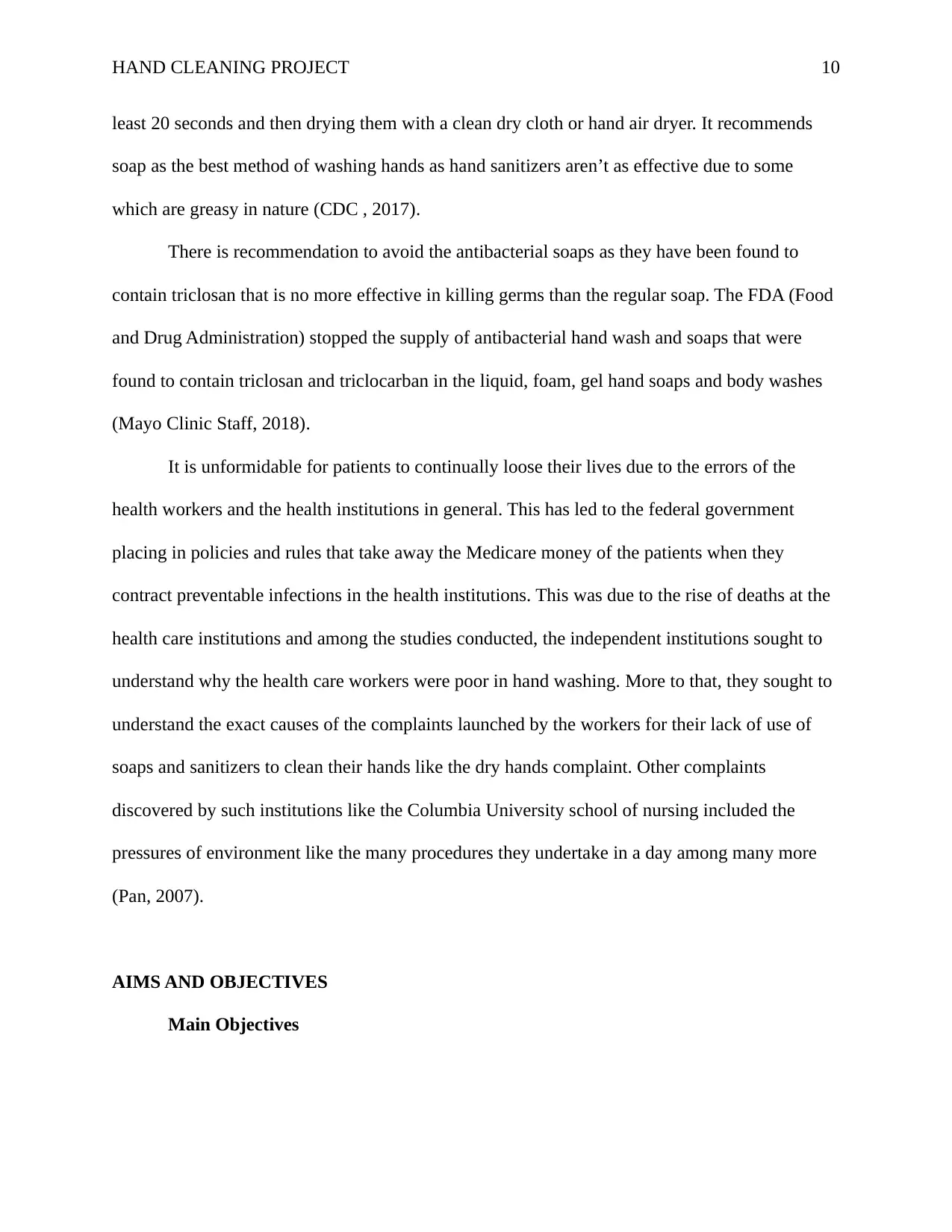
HAND CLEANING PROJECT 10
least 20 seconds and then drying them with a clean dry cloth or hand air dryer. It recommends
soap as the best method of washing hands as hand sanitizers aren’t as effective due to some
which are greasy in nature (CDC , 2017).
There is recommendation to avoid the antibacterial soaps as they have been found to
contain triclosan that is no more effective in killing germs than the regular soap. The FDA (Food
and Drug Administration) stopped the supply of antibacterial hand wash and soaps that were
found to contain triclosan and triclocarban in the liquid, foam, gel hand soaps and body washes
(Mayo Clinic Staff, 2018).
It is unformidable for patients to continually loose their lives due to the errors of the
health workers and the health institutions in general. This has led to the federal government
placing in policies and rules that take away the Medicare money of the patients when they
contract preventable infections in the health institutions. This was due to the rise of deaths at the
health care institutions and among the studies conducted, the independent institutions sought to
understand why the health care workers were poor in hand washing. More to that, they sought to
understand the exact causes of the complaints launched by the workers for their lack of use of
soaps and sanitizers to clean their hands like the dry hands complaint. Other complaints
discovered by such institutions like the Columbia University school of nursing included the
pressures of environment like the many procedures they undertake in a day among many more
(Pan, 2007).
AIMS AND OBJECTIVES
Main Objectives
least 20 seconds and then drying them with a clean dry cloth or hand air dryer. It recommends
soap as the best method of washing hands as hand sanitizers aren’t as effective due to some
which are greasy in nature (CDC , 2017).
There is recommendation to avoid the antibacterial soaps as they have been found to
contain triclosan that is no more effective in killing germs than the regular soap. The FDA (Food
and Drug Administration) stopped the supply of antibacterial hand wash and soaps that were
found to contain triclosan and triclocarban in the liquid, foam, gel hand soaps and body washes
(Mayo Clinic Staff, 2018).
It is unformidable for patients to continually loose their lives due to the errors of the
health workers and the health institutions in general. This has led to the federal government
placing in policies and rules that take away the Medicare money of the patients when they
contract preventable infections in the health institutions. This was due to the rise of deaths at the
health care institutions and among the studies conducted, the independent institutions sought to
understand why the health care workers were poor in hand washing. More to that, they sought to
understand the exact causes of the complaints launched by the workers for their lack of use of
soaps and sanitizers to clean their hands like the dry hands complaint. Other complaints
discovered by such institutions like the Columbia University school of nursing included the
pressures of environment like the many procedures they undertake in a day among many more
(Pan, 2007).
AIMS AND OBJECTIVES
Main Objectives
Paraphrase This Document
Need a fresh take? Get an instant paraphrase of this document with our AI Paraphraser
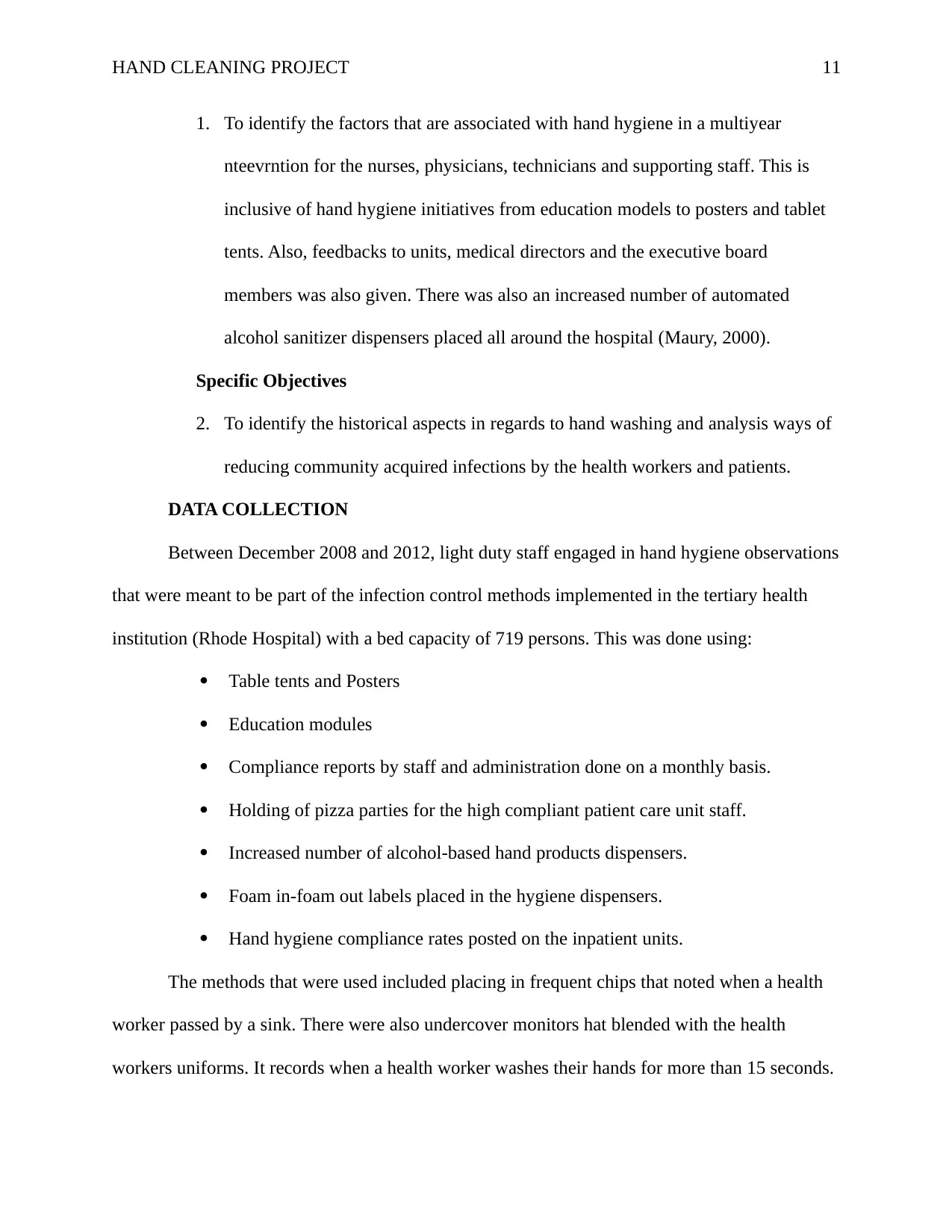
HAND CLEANING PROJECT 11
1. To identify the factors that are associated with hand hygiene in a multiyear
nteevrntion for the nurses, physicians, technicians and supporting staff. This is
inclusive of hand hygiene initiatives from education models to posters and tablet
tents. Also, feedbacks to units, medical directors and the executive board
members was also given. There was also an increased number of automated
alcohol sanitizer dispensers placed all around the hospital (Maury, 2000).
Specific Objectives
2. To identify the historical aspects in regards to hand washing and analysis ways of
reducing community acquired infections by the health workers and patients.
DATA COLLECTION
Between December 2008 and 2012, light duty staff engaged in hand hygiene observations
that were meant to be part of the infection control methods implemented in the tertiary health
institution (Rhode Hospital) with a bed capacity of 719 persons. This was done using:
Table tents and Posters
Education modules
Compliance reports by staff and administration done on a monthly basis.
Holding of pizza parties for the high compliant patient care unit staff.
Increased number of alcohol-based hand products dispensers.
Foam in-foam out labels placed in the hygiene dispensers.
Hand hygiene compliance rates posted on the inpatient units.
The methods that were used included placing in frequent chips that noted when a health
worker passed by a sink. There were also undercover monitors hat blended with the health
workers uniforms. It records when a health worker washes their hands for more than 15 seconds.
1. To identify the factors that are associated with hand hygiene in a multiyear
nteevrntion for the nurses, physicians, technicians and supporting staff. This is
inclusive of hand hygiene initiatives from education models to posters and tablet
tents. Also, feedbacks to units, medical directors and the executive board
members was also given. There was also an increased number of automated
alcohol sanitizer dispensers placed all around the hospital (Maury, 2000).
Specific Objectives
2. To identify the historical aspects in regards to hand washing and analysis ways of
reducing community acquired infections by the health workers and patients.
DATA COLLECTION
Between December 2008 and 2012, light duty staff engaged in hand hygiene observations
that were meant to be part of the infection control methods implemented in the tertiary health
institution (Rhode Hospital) with a bed capacity of 719 persons. This was done using:
Table tents and Posters
Education modules
Compliance reports by staff and administration done on a monthly basis.
Holding of pizza parties for the high compliant patient care unit staff.
Increased number of alcohol-based hand products dispensers.
Foam in-foam out labels placed in the hygiene dispensers.
Hand hygiene compliance rates posted on the inpatient units.
The methods that were used included placing in frequent chips that noted when a health
worker passed by a sink. There were also undercover monitors hat blended with the health
workers uniforms. It records when a health worker washes their hands for more than 15 seconds.
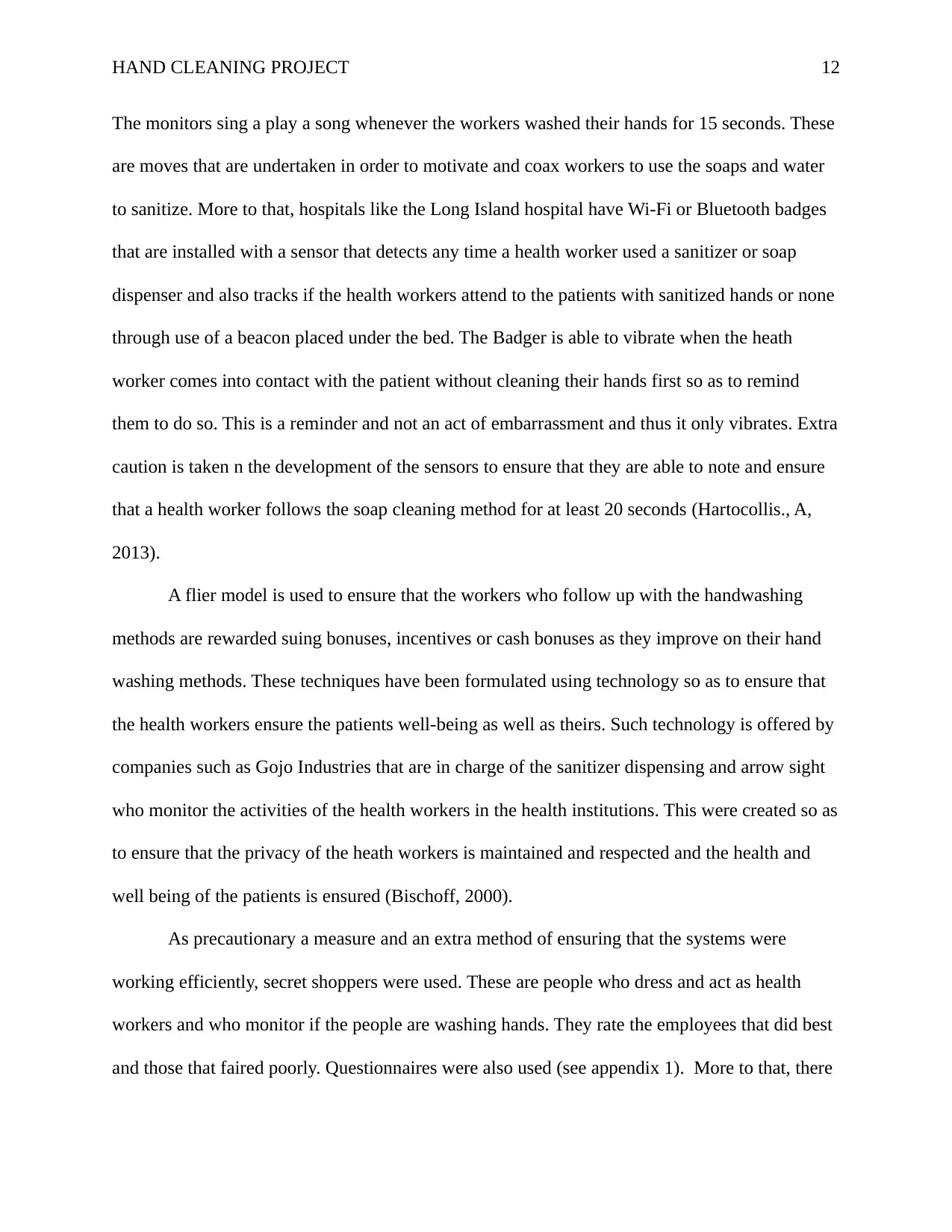
HAND CLEANING PROJECT 12
The monitors sing a play a song whenever the workers washed their hands for 15 seconds. These
are moves that are undertaken in order to motivate and coax workers to use the soaps and water
to sanitize. More to that, hospitals like the Long Island hospital have Wi-Fi or Bluetooth badges
that are installed with a sensor that detects any time a health worker used a sanitizer or soap
dispenser and also tracks if the health workers attend to the patients with sanitized hands or none
through use of a beacon placed under the bed. The Badger is able to vibrate when the heath
worker comes into contact with the patient without cleaning their hands first so as to remind
them to do so. This is a reminder and not an act of embarrassment and thus it only vibrates. Extra
caution is taken n the development of the sensors to ensure that they are able to note and ensure
that a health worker follows the soap cleaning method for at least 20 seconds (Hartocollis., A,
2013).
A flier model is used to ensure that the workers who follow up with the handwashing
methods are rewarded suing bonuses, incentives or cash bonuses as they improve on their hand
washing methods. These techniques have been formulated using technology so as to ensure that
the health workers ensure the patients well-being as well as theirs. Such technology is offered by
companies such as Gojo Industries that are in charge of the sanitizer dispensing and arrow sight
who monitor the activities of the health workers in the health institutions. This were created so as
to ensure that the privacy of the heath workers is maintained and respected and the health and
well being of the patients is ensured (Bischoff, 2000).
As precautionary a measure and an extra method of ensuring that the systems were
working efficiently, secret shoppers were used. These are people who dress and act as health
workers and who monitor if the people are washing hands. They rate the employees that did best
and those that faired poorly. Questionnaires were also used (see appendix 1). More to that, there
The monitors sing a play a song whenever the workers washed their hands for 15 seconds. These
are moves that are undertaken in order to motivate and coax workers to use the soaps and water
to sanitize. More to that, hospitals like the Long Island hospital have Wi-Fi or Bluetooth badges
that are installed with a sensor that detects any time a health worker used a sanitizer or soap
dispenser and also tracks if the health workers attend to the patients with sanitized hands or none
through use of a beacon placed under the bed. The Badger is able to vibrate when the heath
worker comes into contact with the patient without cleaning their hands first so as to remind
them to do so. This is a reminder and not an act of embarrassment and thus it only vibrates. Extra
caution is taken n the development of the sensors to ensure that they are able to note and ensure
that a health worker follows the soap cleaning method for at least 20 seconds (Hartocollis., A,
2013).
A flier model is used to ensure that the workers who follow up with the handwashing
methods are rewarded suing bonuses, incentives or cash bonuses as they improve on their hand
washing methods. These techniques have been formulated using technology so as to ensure that
the health workers ensure the patients well-being as well as theirs. Such technology is offered by
companies such as Gojo Industries that are in charge of the sanitizer dispensing and arrow sight
who monitor the activities of the health workers in the health institutions. This were created so as
to ensure that the privacy of the heath workers is maintained and respected and the health and
well being of the patients is ensured (Bischoff, 2000).
As precautionary a measure and an extra method of ensuring that the systems were
working efficiently, secret shoppers were used. These are people who dress and act as health
workers and who monitor if the people are washing hands. They rate the employees that did best
and those that faired poorly. Questionnaires were also used (see appendix 1). More to that, there
⊘ This is a preview!⊘
Do you want full access?
Subscribe today to unlock all pages.

Trusted by 1+ million students worldwide
1 out of 23
Related Documents
Your All-in-One AI-Powered Toolkit for Academic Success.
+13062052269
info@desklib.com
Available 24*7 on WhatsApp / Email
![[object Object]](/_next/static/media/star-bottom.7253800d.svg)
Unlock your academic potential
Copyright © 2020–2025 A2Z Services. All Rights Reserved. Developed and managed by ZUCOL.





